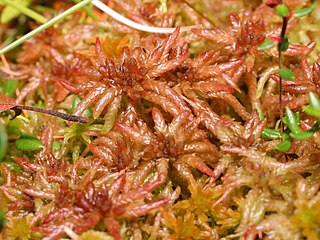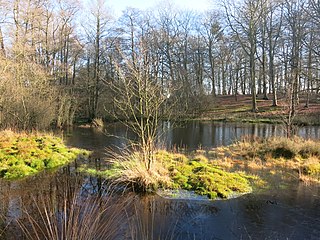
Mosses are small, non-vascular flowerless plants in the taxonomic division Bryophytasensu stricto. Bryophyta may also refer to the parent group bryophytes, which comprise liverworts, mosses, and hornworts. Mosses typically form dense green clumps or mats, often in damp or shady locations. The individual plants are usually composed of simple leaves that are generally only one cell thick, attached to a stem that may be branched or unbranched and has only a limited role in conducting water and nutrients. Although some species have conducting tissues, these are generally poorly developed and structurally different from similar tissue found in vascular plants. Mosses do not have seeds and after fertilisation develop sporophytes with unbranched stalks topped with single capsules containing spores. They are typically 0.2–10 cm (0.1–3.9 in) tall, though some species are much larger. Dawsonia, the tallest moss in the world, can grow to 50 cm (20 in) in height. There are approximately 12,000 species.

Sphagnum is a genus of approximately 380 accepted species of mosses, commonly known as sphagnum moss, also bog moss and quacker moss. Accumulations of Sphagnum can store water, since both living and dead plants can hold large quantities of water inside their cells; plants may hold 16 to 26 times as much water as their dry weight, depending on the species. The empty cells help retain water in drier conditions.

The stratum corneum is the outermost layer of the epidermis. The human stratum corneum comprises several levels of flattened corneocytes that are divided into two layers: the stratum disjunctum and stratum compactum. The skin's protective acid mantle and lipid barrier sit on top of the stratum disjunctum. The stratum disjunctum is the uppermost and loosest layer of skin. The stratum compactum is the comparatively deeper, more compacted and more cohesive part of the stratum corneum. The corneocytes of the stratum disjunctum are larger, more rigid and more hydrophobic than that of the stratum compactum.
This article gives an overview of the mire plant communities in the British National Vegetation Classification system.

Thurstaston Common is an area of almost 250 acres (100 ha) of parklands, wood and heath between Frankby and Thurstaston, on the Wirral Peninsula in North West England. The common is jointly owned by the National Trust and the Metropolitan Borough of Wirral. Royden Country Park is nearby and offers additional facilities.

Norsey Wood is a 67.2-hectare (166-acre) biological Site of Special Scientific Interest in Billericay, Essex. It is also a Local Nature Reserve and a Scheduled Monument.
In the mathematical study of functional analysis, the Banach–Mazur distance is a way to define a distance on the set of -dimensional normed spaces. With this distance, the set of isometry classes of -dimensional normed spaces becomes a compact metric space, called the Banach–Mazur compactum.

Beckley Bog is a sphagnum-heath-black spruce bog located near Norfolk in Litchfield County, Connecticut. It is the southernmost sphagnum heath bog in New England. The peat moss is over 51 feet deep. It was declared a National Natural Landmark in May 1977.

Dendrobium bigibbum, commonly known as the Cooktown orchid or mauve butterfly orchid, is an epiphytic or lithophytic orchid in the family Orchidaceae. It has cylindrical pseudobulbs, each with between three and five green or purplish leaves and arching flowering stems with up to twenty, usually lilac-purple flowers. It occurs in tropical North Queensland, Australia and New Guinea.

Sphagnum magellanicum, commonly called Magellanic bogmoss, Magellan's sphagnum, Magellan's peatmoss or midway peat moss, is a widespread species of moss found in wet boreal forest in the far south and southwest of South America, North America and Eurasia.
Within plant communities, NVC Community M16 is one of the 38 mire communities in the British National Vegetation Classification system.

Kingsley Common is a 41-hectare (100-acre) protected area in Kingsley, Hampshire, England. The site holds many rare species of animals and birds. Some species of plants and animals may also be subject to special protection under Part I of the Wildlife and Countryside Act 1981, or under the Habitats Regulations 1994.

Hydnellum compactum is a tooth fungus in the family Bankeraceae. It is found in Europe, where it grows in deciduous forest, typically under beech. Fruit bodies of the fungus grow singly or in groups. They are top-shaped, with convex or flattened upper surfaces up to 10 cm (4 in) in diameter. The surface texture is initially felt-like before becoming pitted and rough in age. The stipe, roughly the same color as the cap, is solid and measures 2–4 cm (0.8–1.6 in) long by 1–3 cm (0.4–1.2 in) thick. On the fertile cap underside are white to purple-brown, curved spines up to 5 mm long. The color is whitish at first but gradually turns dark brown to blackish. Its spores measure 5.5–6 by 3.5–4.5 µm, and feature tubercles that sometimes have a sunken tip. It is considered endangered in Switzerland.

Triticum compactum or club wheat is a species of wheat adapted to low-humidity growing conditions. T. compactum is similar enough to common wheat that it is often considered a subspecies, T. aestivum compactum. It can be distinguished by its more compact ear due to shorter rachis segments, giving it its common name. In the United States of America, nearly all T. compactum is grown in dry areas of the Pacific Northwest.

Wellington College Bog is a 6.2-hectare (15-acre) biological Site of Special Scientific Interest in the grounds of Wellington College on the northern outskirts of Sandhurst in Berkshire.

Sole Common Pond is a 3-hectare (7.4-acre) nature reserve south-west of Boxford in Berkshire in Berkshire. It is managed by the Berkshire, Buckinghamshire and Oxfordshire Wildlife Trust.

Heteroplacidium compactum is a species of areolate, crustose lichen in the family Verrucariaceae. It has a cosmopolitan distribution. It is a lichenicolous lichen, growing as a facultative parasite on other lichens, typically on non-calcareous rock. It has rod-shaped (bacilliform) conidia measuring 5–7 μm long, and ascospores that are 11–18 by 8–10 μm. Heteroplacidium zamenhofianum is a closely related species distinguished by having perithecia situated in the algal layer, and smaller ascospores with a more narrow ellipsoid shape.














